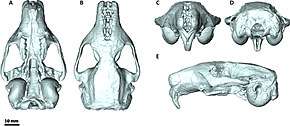Leithia
Leithia is a genus of extinct giant dormice from the Mediterranean islands of Malta and Sicily. It is considered an example of island gigantism.
| Leithia Temporal range: Pleistocene | |
|---|---|
 | |
| Model of the skull of L. melitensis | |
| Scientific classification | |
| Kingdom: | Animalia |
| Phylum: | Chordata |
| Class: | Mammalia |
| Order: | Rodentia |
| Family: | Gliridae |
| Subfamily: | Leithiinae |
| Genus: | †Leithia Lydekker, 1896 |
Island fossils
Leithia was proposed in 1896 by Richard Lydekker as the type genus of the Leithiinae.[1] It is estimated to have weighed up to 113 g (4.0 oz). In the time before the Mediterranean islands were colonised by humans, dozens of mammal species endemic to the area, some unusually large like Leithia, some unusually small (such as pygmy elephants and hippopotamuses) lived in Malta and Sicily, while another giant dormouse, Hypnomys, lived on Mallorca to the west. In an instance of island gigantism, the dormice were able to grow large in the absence of predators on these islands, which otherwise force rodents to hide in holes or cracks, requiring them to be small.[2] Two species of Leithia, namely L. melitensis (the Maltese giant dormouse) and L. cartei, lived in Sicily.[3] The skull of L. melitensis was 10 cm long.[4]
See also
References
- Wilson, Don E.; Reeder, DeeAnn M., eds. (2005). Mammal Species of the World: A Taxonomic and Geographic Reference, Volume 12. JHU Press. p. 829.
- Davis, Simon (3 January 1985). "Tiny Elephants and Giant Mice". New Scientist: 25–27.
- Petronio, C. (1970). "I Roditori Pleistocenici della Grotta di Spinagallo (Siracusa)" (PDF). Geol. Rom. IX: 149–194. (in Italian)
- Davis, Simon (1987). The Archaeology of Animals. Psychology Press. pp. 120–121.